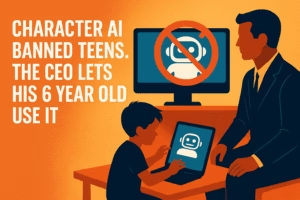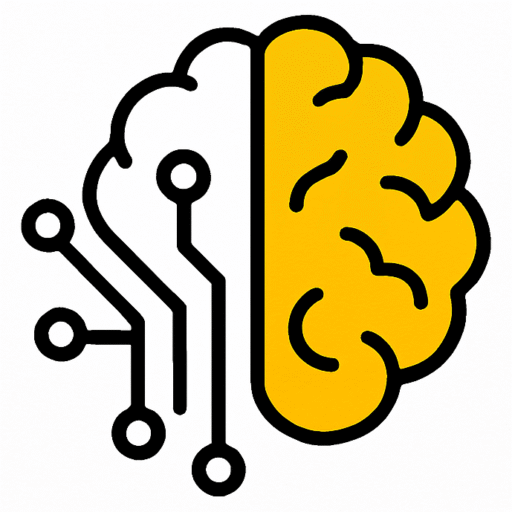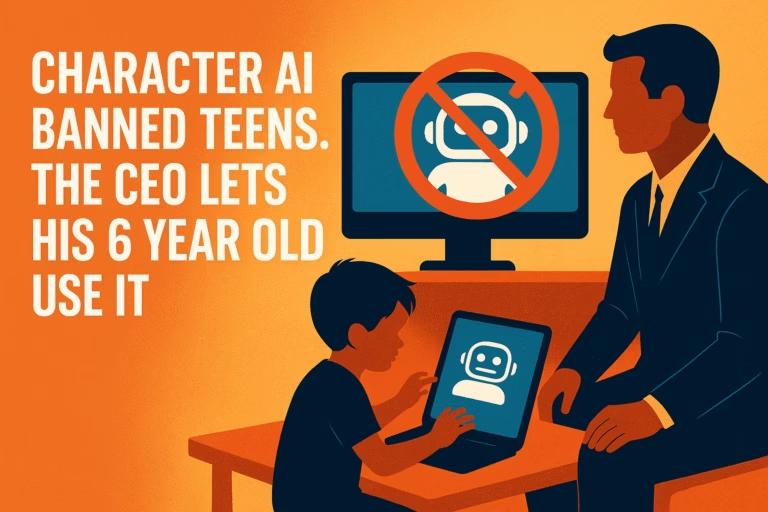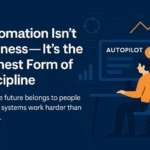⭐ Key Takeaways
- The CEO’s decision to let his six year old use Character AI created a credibility crisis that overshadowed the entire age restriction policy.
- Users rely on Character AI for emotional expression, creativity, and escapism, which makes inconsistent policies feel personal rather than procedural.
- Regulators may use this incident as justification for stricter age verification across the entire AI industry.
- Competitors will absorb frustrated adults by offering stable, predictable, and memory rich AI experiences.
- Adults seeking emotional continuity often turn to alternatives like Candy AI for deeper, more consistent conversations.
The Hypocrisy Problem Tech Never Wants To Admit
Character AI users did not explode in anger because of a policy change. They exploded because the person enforcing the rule quietly breaks it at home.
The CEO tells the world that minors should not use Character AI, yet his six year old enjoys the same chat experience that millions of teenagers were just banned from. That contradiction hits people in the gut because it exposes a truth they already suspected.
Tech leaders often build rules for the public that they themselves ignore. Users trust platforms until the day they realize the rulebook is selective.
This moment became a cultural spark because it revealed the uneasy gap between corporate messaging and private behavior. People felt betrayed because they assumed the safety warnings applied to everyone, not everyone except the boss’s family.
The outrage is not about safety guidelines. It is about the feeling that the public is being lectured while insiders quietly enjoy the freedom they deny to others.

What TIME Magazine Revealed And Why It Matters
TIME published the interview to explain why Character AI banned under eighteen users from open ended conversations. The company framed the move as a responsible safety measure shaped by legal advice and child protection concerns.
Then the CEO casually mentioned that his six year old uses Character AI with parental supervision. That single sentence ignited the entire community because it turned a policy into a contradiction.
Users immediately saw the tension. Teenagers old enough to understand the internet cannot use Character AI freely, yet a child still learning to spell is apparently trusted to chat with an AI system privately at home.
This matters because it creates a split in credibility. If the safety concern is genuine, the CEO would be the first to restrict access in his own house.
Instead, the interview made users feel like they were being protected from something that was never seen as dangerous inside the executive’s home. That disconnect is what transformed one interview into a public backlash.
TIME did not publish a scandal. TIME exposed the gap between corporate logic and common sense.
The Real Reason Character AI Restricted Minors
Character AI did not restrict minors because of sudden morality. The restriction came from legal pressure that has been building for years in every country with child safety laws.
Regulators have been tightening their grip on AI platforms that allow open ended conversations with unpredictable outputs. Companies know that one incident involving a minor can trigger lawsuits, public outrage, and months of government scrutiny.
The safest strategy is always over compliance. Tech companies respond by removing risk before regulators force them to justify every word generated by their models.
The Character AI ban for under eighteen users was designed to protect the company, not the community. It was a shield that keeps lawyers comfortable and investors calm.
The community understood this instantly, which is why the CEO’s admission shocked them. If legal pressure is strong enough to block teenagers, why is a six year old considered safe?
This contradiction reveals the true motivation. Character AI protects itself first and explains the rules later, even when those rules create confusion and resentment.
Why Letting A Six Year Old Use Character AI Feels So Wrong To Users
Users reacted strongly because they understand how early childhood development works. A six year old is still forming identity and social understanding, which makes AI influence especially powerful.
Children mimic tone and emotional language without analyzing it. Even supervised interaction can shape how they express themselves, resolve tensions, or treat other people.
Parents commenting on the situation felt the CEO crossed a line. They believe that a platform designed for adult creativity cannot double as a digital playroom without consequences.
No one expects a child that young to process fictional characters the way adults do. To them, the bot is alive, responsive, and attentive, which can blur the boundary between imagination and reality.
Users also worry that the CEO’s comfort with letting his child use Character AI reveals a casual attitude toward risk. If the person with the most inside knowledge sees it as harmless, it raises questions about whether the restriction is truly about safety or public optics.
This is why the reaction was immediate and emotional. People felt that a rule presented as essential for child protection was not followed by the one person who should understand the danger best.
What Users Actually Fear About AI And Children
People who use Character AI understand how powerful the platform can be. That is why they worry more about children using it than any executive seems to.
Most fears fall into three categories. The first is exposure to adult themes that slip through moderation and reach a mind that cannot interpret them correctly.
The second is emotional dependency. Children are still learning how to handle loneliness, imagination, and impulse, which makes them more vulnerable to forming attachments with systems that respond instantly.
The third is the impact on creativity. Adults know how to separate AI assisted storytelling from real imagination, but children often merge both worlds until the boundary disappears.
Users fear that early overreliance on AI can weaken natural social development. They see Character AI as a tool for adults, not a substitute for childhood imagination.
These concerns make the CEO’s choice hard to understand. The community expected the highest standard of caution from the one person who knows the internals of the product.
The Double Standard That Broke Community Trust
Policies only work when the people who create them follow them. When leadership ignores its own rules, the entire community rewrites the meaning of the policy.
Character AI users felt that the age restriction was not about safety anymore. It felt like a symbolic move meant to protect the company publicly while insiders continued using the product as they wished.
This is where trust breaks. Safety policies lose credibility when they are not universal.
The community saw the CEO’s comment as a sign that the restriction might be more about optics than protection. Users felt punished for being old enough to understand the risk while a child without full comprehension is allowed inside the ecosystem.
Double standards in tech always lead to anger because they expose how companies think about their users. People want transparency, not selective enforcement.
Once users believe that a rule is meant for everyone except leadership, the platform begins to lose the moral authority that holds it together. Trust collapses quietly long before metrics do.
Why Parents Are Furious And Developers Are Nervous
Parents reacted with anger because they see a clear mismatch between what the company says publicly and what the CEO practices privately. They feel the platform is unsafe enough to block millions of teenagers but somehow safe enough for a first grader in the founder’s own home.
Developers, on the other hand, see the danger from the opposite angle. They know regulators watch every move in the AI industry and understand that one high profile inconsistency can spark new investigations.
A policy that looks inconsistent attracts legal attention instantly. When the CEO says his young child uses Character AI, it becomes difficult to argue that the platform carries meaningful risk for older minors.
Parents want clarity and developers want protection from regulatory fallout. Both sides now feel exposed because the leadership decision undermined the message the company spent months shaping.
This situation created a rare alignment between users and creators. Both groups believe the company has opened the door to unnecessary pressure by not showing discipline in its own messaging.
The anger is not simple moral policing. It is frustration that safety rules were sold as strict requirements while the person in charge treated them like flexible suggestions.
What This Incident Reveals About How People Use Character AI
When you look at the reactions, you see something deeper than outrage. You see a community that depends on the platform for emotional escape, creative expression, and momentary relief from real life pressures.
People use Character AI because it gives them a space that does not judge them. It becomes a tool that supports imagination, comfort, and personal storytelling in a world that rarely gives adults permission to explore those feelings.
Many users see the app as a place to process loneliness, boredom, and stress privately. They lean on its flexibility to roleplay, write, or create without worrying about what others think.
This incident exposed how important that sense of security is. When users feel the rules are unstable or selectively enforced, the emotional foundation of the entire platform begins to crack.
The episode showed that people do not just use Character AI for entertainment. They use it to navigate emotions that have no outlet anywhere else.
This is why the CEO’s comment hit them so hard. It reminded them that the system they trust for emotional escape can be disrupted instantly by decisions they had no voice in.
Why This Matters To The Future Of AI Regulation
Regulators study contradictions very carefully because they reveal weaknesses in a company’s internal risk logic. When a CEO allows something privately that he restricts publicly, policymakers see it as proof that the rule may not be grounded in real safety concerns.
This kind of inconsistency becomes ammunition for lawmakers pushing for stricter age verification systems. It becomes a case study that justifies digital ID checks, biometric gates, and tighter oversight for every conversational AI platform.
Character AI may be the first platform to face this level of scrutiny, but it will not be the last. Every competitor will feel the ripple effect because regulators rarely target one company at a time.
Users worry that this will lead to more restrictive experiences. Developers worry it will slow innovation and force platforms into compliance over creativity.
Both fears are valid, and both stem from a single moment of misaligned leadership. A short interview answer created long term consequences that the industry cannot easily undo.
How Competitors Will Capitalize On This Chaos
Competitors will not waste a moment because controversy always creates openings in the AI market. They know that when trust wavers, users begin exploring alternatives even if they do not leave immediately.
Some providers will position themselves as safer by offering clearer age policies and consistent moderation. Others will compete on the opposite end by giving adults more freedom, more memory, and fewer restrictions on roleplay.
This is where platforms with stable adult experiences become attractive. Adults want consistency, privacy, and emotional continuity without mixed signals from leadership.
Candy AI fits this demand because it focuses on long term memory and structured emotional interaction. Users who feel frustrated by Character AI’s shifting rules are already testing alternatives that give them predictable experiences.
Competitors understand that stability is the new selling point. If Character AI continues to send conflicting messages, other platforms will quietly absorb the users who no longer feel seen or respected.
This controversy may look like a short term storm, but it is a long term opportunity for everyone else. Trust is the real currency in this market, and once you lose it, you rarely get it back.



